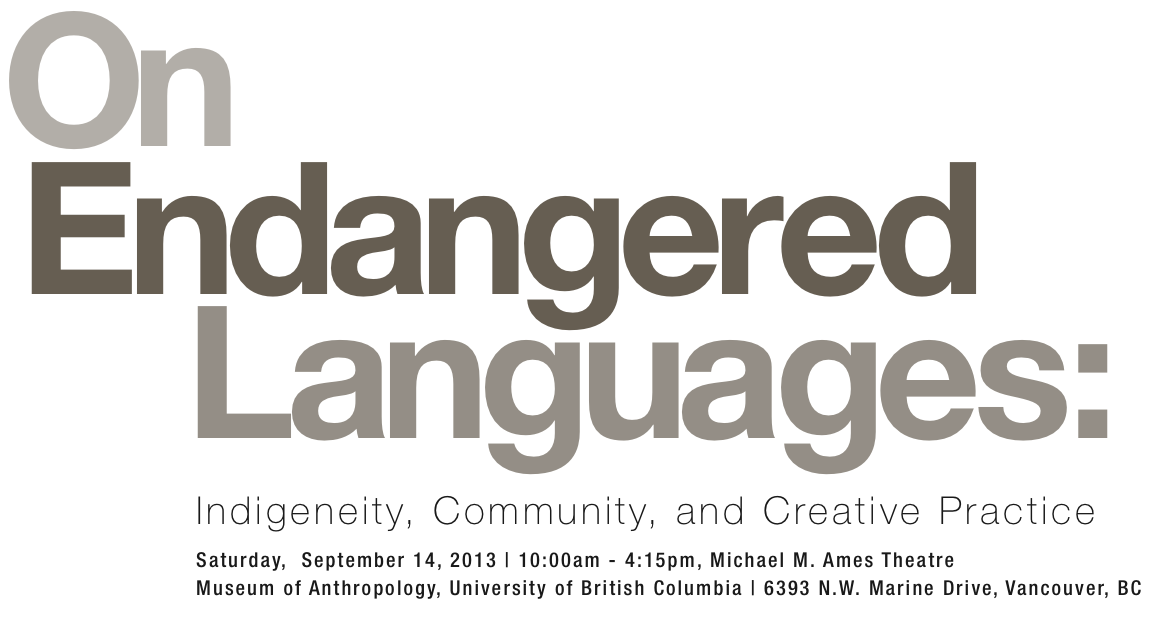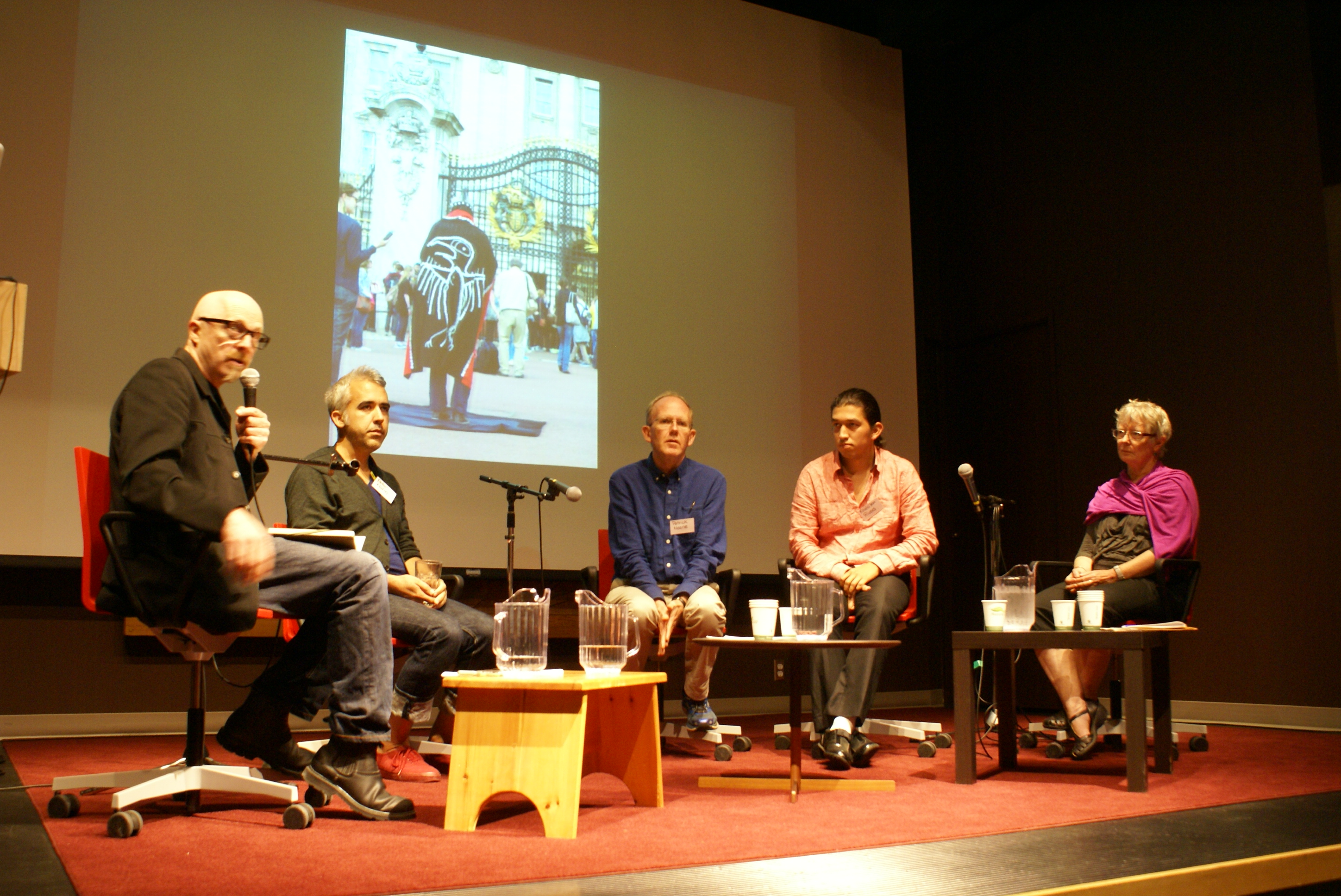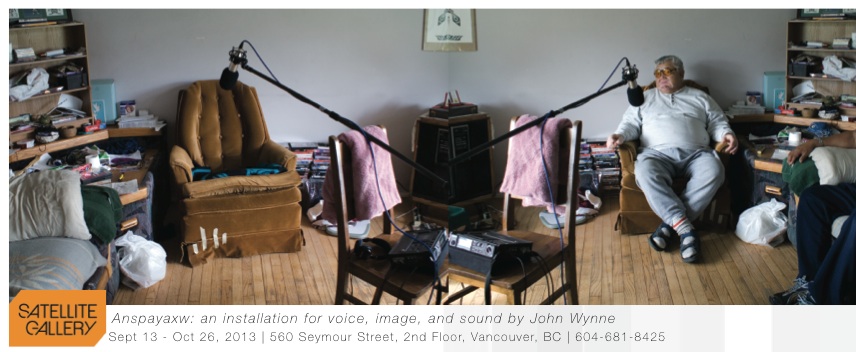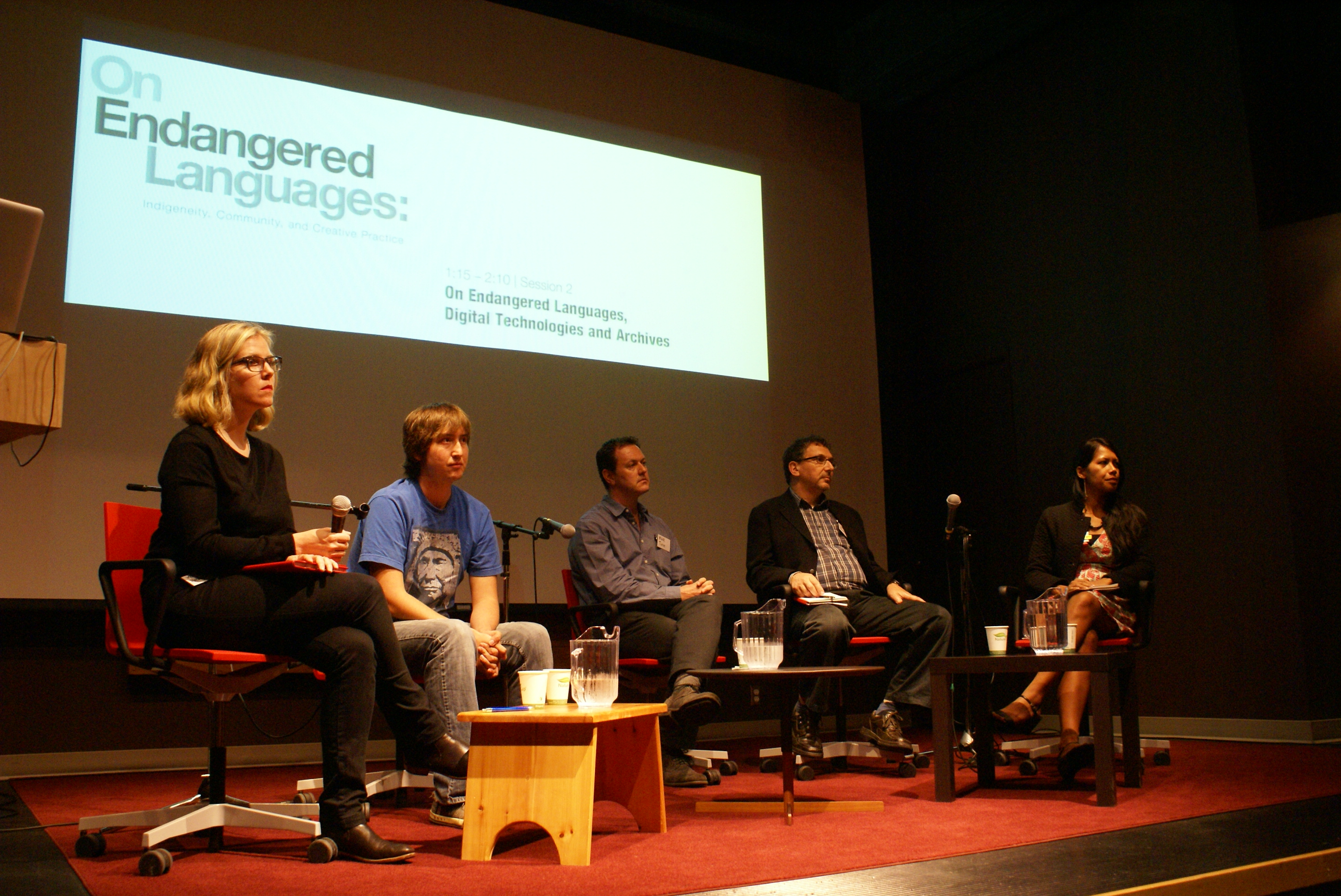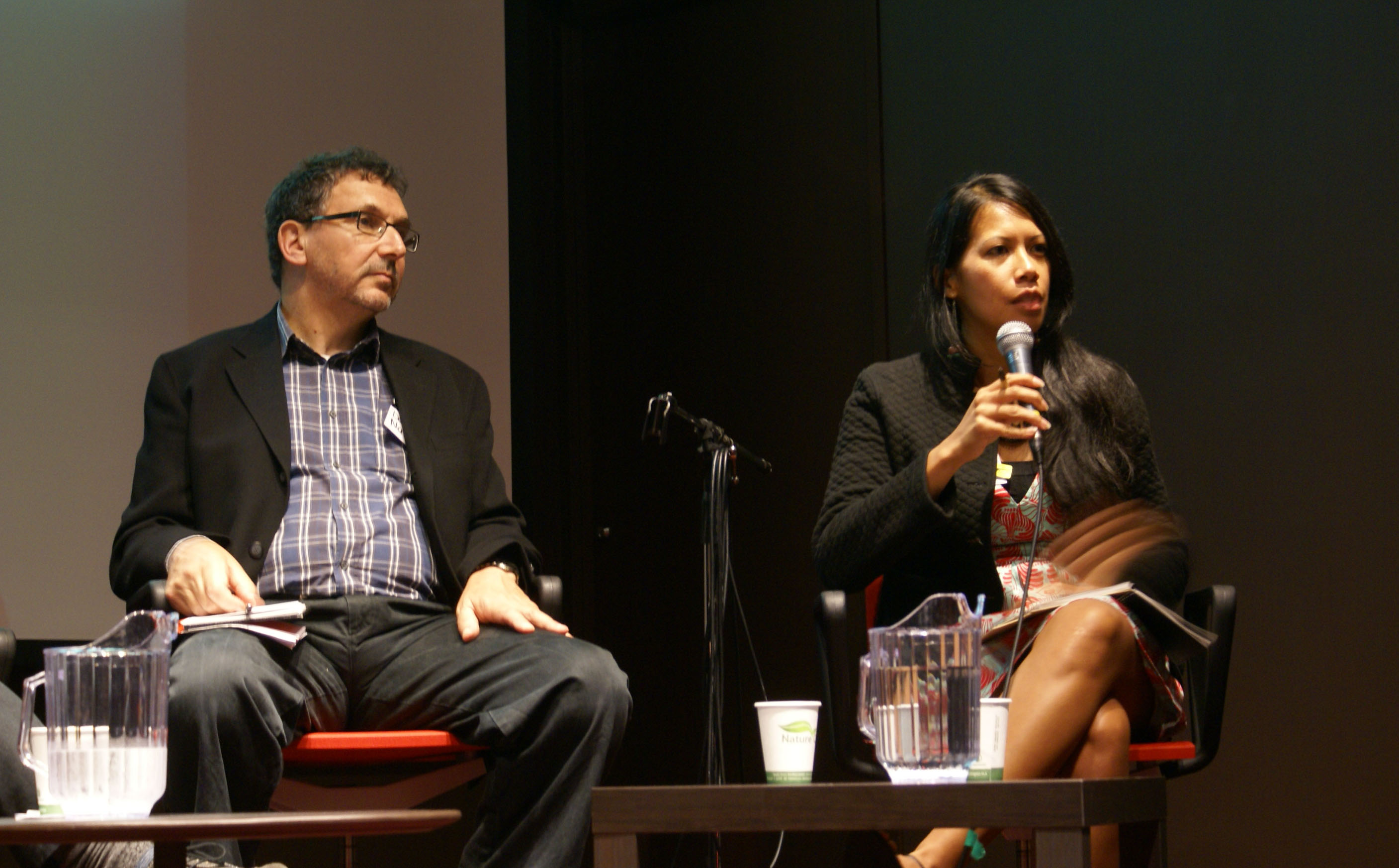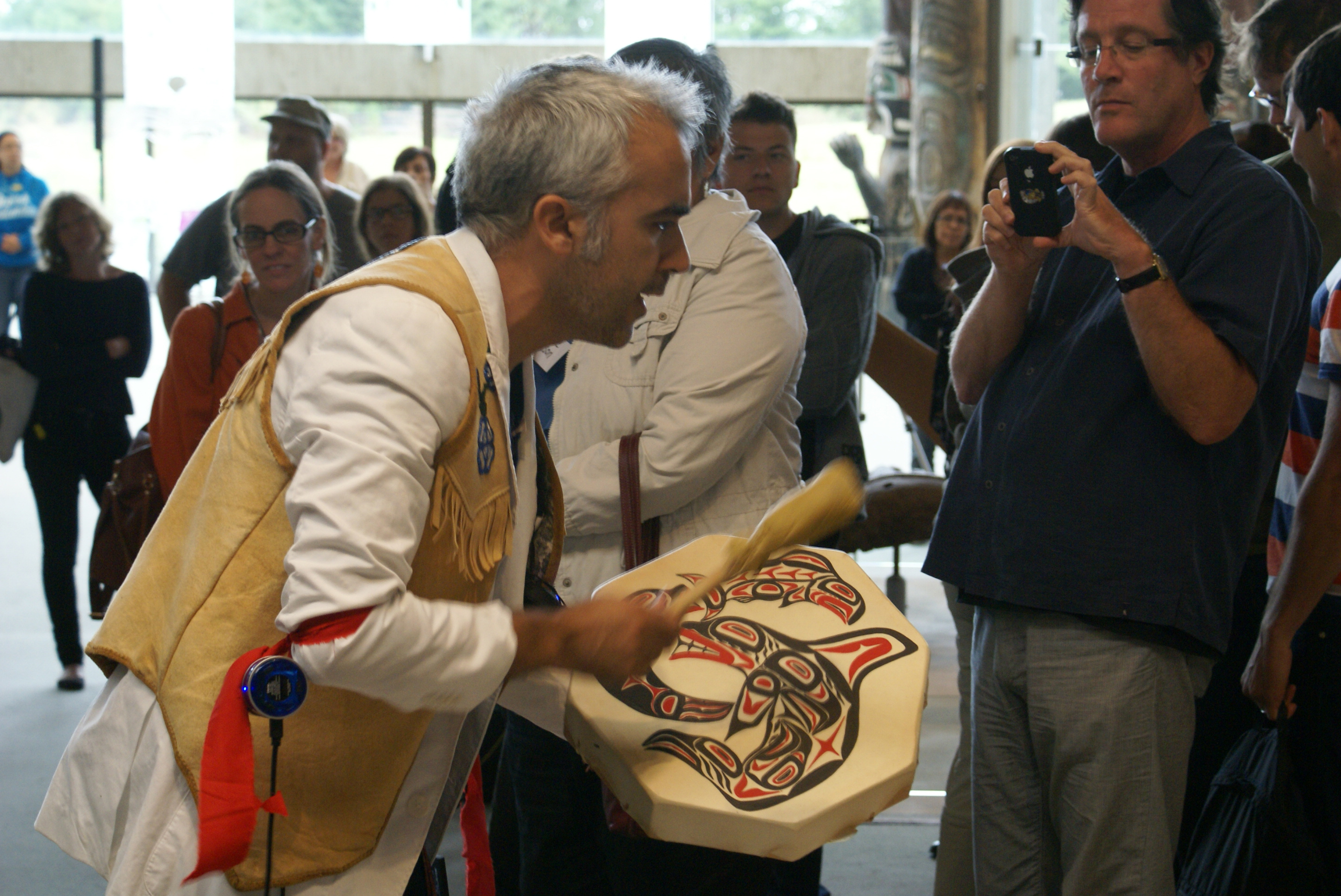The public symposium On Endangered Languages––Indigeneity, Community, and Creative Practice took place on September 14, 2013 at the Museum of Anthropology at the University of British Columbia. It was co-organized by Karen Duffek (MOA), Kate Hennessy (Simon Fraser U, SIAT), Tyler Peterson (U Arizona) and John Wynne (U of Arts, London), in conjunction with the exhibition of John Wynne’s immersive sound and photographic work Anspayaxw at the Satellite Gallery in Vancouver. Download the online exhibit catalogue here.
Thank you to our supporters: the Museum of Anthropology at UBC; the UBC Department of Anthropology; the UBC First Nations Languages Program; The Irving K. Barber Centre; Simon Fraser University’s School of Interactive Arts and Technology; University of the Arts, London; and the University of Arizona. The symposium was webcast by UBC’s Irving K. Barber Centre; scroll down for videos of each of the three sessions of the day.
Session 1: Language Documentation and the Anspayaxw Project
Introduction by Karen Duffek; Presentation by John Wynne and Tyler Peterson: The Anspayaxw Project
Chair: Tyler Peterson
Panelists: Patricia Shaw, Barbara Harris, Louise Wilson, Cynthia Jensen-Fisk, Loretta Todd, Larry Grant, John Wynne.
In recent decades there has been a flurry of language documentation, maintenance, and revitalization initiatives. In this session we engage in the ongoing discussion of the ways these initiatives can be developed and directed. Using the Anspayaxw project as a starting point, this entails touching on issues surrounding language community involvement, the linguist-speaker research relationship, community-led language activities, and the sustainability of long-term projects. We will also extend this discussion by asking: What are the ethical and creative boundaries of what we might call a ‘traditional’ language documentation and/or maintenance project?
Session 2: On Endangered Languages, Digital Technologies and Archives
This panel followed a screening of Banchi Hanuse’s film ‘Cry Rock’.
Chair: Kate Hennessy.
Panelists: Candace Galla, David Nathan, Mark Turin, Clyde Tallio.
As documentary and archiving technologies rapidly change, we ask: What role does the digital play in the preservation––or conversely, the loss––of documentary media? What uses and reuses of language documentation are appropriate and who, ultimately, are the beneficiaries of these documentary initiatives? Has digital technology facilitated community access and control of language archives and served the ongoing project of endangered language revitalization? How might this be either complicated or enlivened by the politics and practices of digital circulation and remix?
Session 3: Endangered Languages, Creative Practice and Activism
This panel followed a performance by artist Peter Morin entitled ‘Hello Darlin’’.
Chair: John Wynne.
Panelists: Margery Fee, Patrick Moore, Peter Morin, Khelsilem Rivers.
This session explores the museum as a site of cultural contestation and issues of appropriation and commodification. How is cultural identity conveyed in art – by whom and for whom? We hope to explore a variety of perspectives. One view is that in dealing with Indigenous issues, non-Indigenous artists and researchers are simply engaging in ‘metaphorical microcolonialism’ (Corbett). Alternatively, some see in cross-cultural collaborations the potential for ‘a dialogue across the boundaries of oppositions’ (Smith). As such, how do ethical considerations and artistic license co-exist? Are issue-based and socially-engaged artistic practice simply a less effective form of activism or do they have a unique contribution to make in defining cultural identity and promoting recognition of the value of indigenous languages?
Symposium Abstract:
As the multi-sensory installation Anspayaxw opens for exhibition in the Satellite Gallery in Vancouver, we bring artist John Wynne, linguist Tyler Peterson, anthropologist Kate Hennessy, Musqueam elder Larry Grant, and Gitxsan participants Louise Wilson and Barbara Harris into conversation with scholars and artists on the preservation of endangered languages, the interconnected role of digital media, and engagements with artistic practice.
Linda Tuhiwai Smith has described research as “probably one of the dirtiest words in the indigenous world’s vocabulary” – but as she also acknowledges, “at some points there is, there has to be, dialogue across the boundaries of oppositions.” Beyond the customary exploration of academic interests and language maintenance efforts, this symposium will problematize research and raise questions about the opportunities and consequences of language documentation for local communities and collaborating outsiders.
The Truth and Reconciliation Commission has drawn attention to the enduring significance of Indigenous languages. Against this backdrop we will explore some of the ways in which language documentation is being used by speakers to communicate identity, sovereignty, and contemporary representations of community. We will further examine the ethical and moral obligations created in the act of documentation, while questioning how research relationships and collaborations might raise awareness of the status of endangered languages. As documentary and archiving technologies rapidly change, we ask what role digital technology plays in the preservation––or conversely, the loss––of documentary media. What are appropriate uses and reuses of language documentation, and who, ultimately, are the beneficiaries of these documentary initiatives? In the context of Anspayaxw, are creative and artistic explorations of language documentation at odds with the goal of revitalization, or do they open up new possibilities for understanding the complex social and historical territory of ongoing colonial relationships?
Wynne’s Anspayaxw (2010) is a 12-channel sound and photography installation based on his collaborations with Tyler Peterson, artist/photographer Denise Hawrysio, and members of the Gitxsan community at Kispiox, British Columbia. Using innovative sound technology, the installation merges recordings of the endangered Gitxsanimaax language, oral histories, and songs with situational portraits of the participants and photographs of hand-made street signs on the reserve made by one of the participants in the 1970s. The work highlights the subjective nature of language documentation, interpretation, and creative expression. The complex relationships between linguistic researchers and language speakers are recognized and represented in image and sound, cut through by questions of power, ownership, and the desire to document, preserve, and revitalize endangered languages.
Participants
Karen Duffek is the Curator of Contemporary Visual Arts and Pacific Northwest at the UBC Museum of Anthropology. Among her recent exhibitions are Peter Morin’s Museum (co-developed with Peter Morin, Satellite Gallery, 2011) and Border Zones: New Art across Cultures (MOA, 2010), which featured the work of 12 international artists, including Anspayaxw by John Wynne.
Larry Grant is a Musqueam elder, and the current Elder-In-Residence for the First Nations House of Learning. Born and raised in Musqueam traditional territory by a traditional henqeminem speaking Musqueam family, Larry worked for 4 decades as a tradesman before enrolling in the First Nations Languages Program. His time in the program revived his memory of the embedded value that the henqeminem language has to self-identity, kinship, culture, territory, and history prior to European contact. Larry is presently assisting in the revitalization of henqeminem and co-teaching the introductory henqeminem course.
Margery Fee is a Professor of English at UBC where she teaches science fiction, science and technology studies and Indigenous literatures. In 2008, she was Distinguished Scholar in Residence at the Peter Wall Institute of Advanced Studies, writing about how some discourses of genetics/genomics contribute to the racialization of minority groups, particularly Indigenous people. Her current research project is Wacousta’s Dilemma: Literature and Land Claims, which examines how land ownership figures in the work of both Indigenous and non-Indigenous people.
Candace Kaleimamoowahinekapu Galla (Native Hawaiian) is an Assistant Professor in the Department of Language & Literacy Education at the University of British Columbia. Her research areas are in language revitalization and education, specifically exploring how technology and media are used to revitalize, perpetuate and promote Indigenous languages.
Barbara Harris is a Gitksan elder from Kispiox, BC. Over the past decade she has dedicated considerable time and effort to Gitksan language maintenance and revitalization. She also works closely with linguists at the UBC department of linguistics, and has made substantial contributions to deepening our understanding of the finer points of the Gitksan language. She is one of 6 Gitxsan speakers featured in John Wynne’s Anspyaxw installation.
Kate Hennessy is a media anthropologist and Assistant Professor at Simon Fraser University’s School of Interactive Arts and Technology. As Director of the Making Culture Lab, she studies the role of new technologies and collaborative research practices in the documentation and safeguarding of cultural heritage. She is a co-founder of the Ethnographic Terminalia Curatorial Collective, which curates exhibitions at the intersection of ethnography and contemporary art.
Cynthia Jensen-Fisk Cindyhl wa’y ii Laax Lo’ophl wa’m Gitx’san’y. Gisk’haast wil naa t’ahl’y ii wilps Geel wil saa witxw’y ii Ansbayaxw wil saa witxw’y. My name is Cindy and Laax Lo’op is my Gitx’san name. My clan is Fireweed. I am from the house of Geel, from the village of Ansbayaxw. I started the Doreen Jensen Memorial Gitx’san Language Class in 2009 in memory of my mother. She believed that both the language and the culture of the Gitx’san were “Just sleeping”. She worked her entire life to re-awaken them. It is my honour to carry on the traditions of my ancestors and follow in my mother’s footsteps of paving the way to ensuring that our language and culture never dies.
Patrick Moore is Associate Professor of Anthropology at the University of British Columbia. He has worked with Athabaskan languages in Alberta, the Yukon, and British Columbia for over three decades. With Angela Wheelock, he translated and co-edited Wolverine: Myths and Visions and Dene Gedeni: Traditional Lifestyles of Kaska Women. He edited a collection of Kaska stories Dene Gudeji: Kaska Narratives and wrote a Kaska, Mountain Slavey and Sekani noun dictionary Gūzāgi K’ū́gé’.
Peter Morin is a Tahltan Nation artist and curator. His work has been exhibited in numerous galleries, including the Royal Ontario Museum, Open Space (Victoria), MOA Satellite Gallery (Vancouver) and Urban Shaman Gallery (Winnipeg). His artistic practice investigates the impact between indigenous culturally-based practices and western settler colonialism. Morin recently completed a series of new performance works for the Indigenity in the Contemporary World research initiative at Royal Holloway University, London, UK.
David Nathan is Director of the Endangered Languages Archive at SOAS, University of London, where his team has developed new approaches to archiving language resources. With 20 years experience in education and electronic publishing for endangered languages, he is interested in the connections between language documentation, research and revitalisation, and how media technologies can support these connections.
Tyler Peterson is a linguist and Assistant Professor at the University of Arizona who works on Gitksan. His research interests focus on how understudied languages such as Gitksan can enrich our empirical and theoretical understanding of how meaning is embodied by language. This work is balanced with a strong interest in endangered language documentation, maintenance and revitalization.
Khelsilem Rivers was born in North Vancouver, BC in 1989 and recently given the names Sxwchálten and X̱elsílem by his paternal grandmother, Audrey Rivers (Tiyáltelut) of the Sḵwx̱wú7mesh. His work has been focused on the rebuilding of Indigenous language fluency in the face of language speaker decline. He is a strong believer that “languages don’t die in healthy communities”, and as such has worked on the concurrent effort of rebuilding healthy community through language-fluency revitalization and vice versa.
Patricia A. Shaw is the founding Chair (1996-present) of the First Nations Languages Program at UBC. She has worked in close collaboration with several critically endangered language communities to record and analyze extant grammatical knowledge, to teach research skills and archiving methodologies, and to develop pedagogical materials for language revitalization.
Clyde Tallio is a Nuxalk language and oral history teacher, from Bella Coola B.C. He is featured prominently in Banchi Hanuse’s film Cry Rock.
Loretta Todd is a filmmaker known for powerful, visual storytelling. Her work has screened at Sundance, Toronto International Film Festival and MOMA. Her many honours and awards include a Rockefeller Fellowship to NYU. Todd created and produced Tansi! Nehiyawetan (APTN) – a children’s series that teaches Cree using storytelling, music videos, games and adventures. She also conceived and developed My Cree, a free language app available in the iTunes store.
Mark Turin is a linguist and anthropologist of Italo-Dutch origin. He is Program Director of the Yale Himalaya Initiative, and Director of the World Oral Literature Project and the Digital Himalaya Project. He will join UBC as Chair of the First Nations Languages Program in July 2014.
Louise Wilson Atdi anlakthl wa’ay, Anspayaxw wil sa’witx’wi. Wilps Luushl wil xsilag’y, Lax Gibuu dihl Galdo’oo. My name is Antdi anlakt, I am from Anspayxw. I am from the House of Luus, Wolf clan from Galdo’oo.
John Wynne is an award-winning sound artist whose work includes site-specific installations, ‘composed documentaries’ for radio, projects with speakers of endangered languages and a body of work with heart and lung transplant recipients. He has a PhD from Goldsmiths College, University of London and is a Reader in Sound Arts at the University of the Arts London.
Download:
On Endangered Languages Symposium Poster
On Endangered Languages Symposium Brochure
Sponsors:


